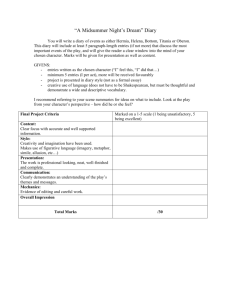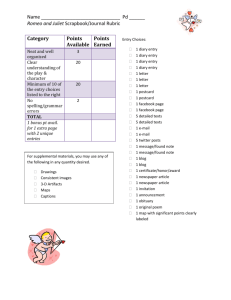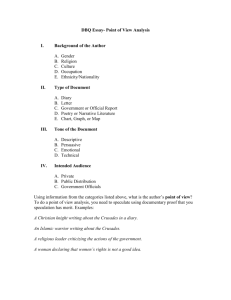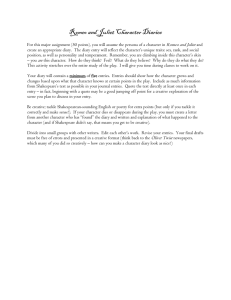Document 10467279
advertisement
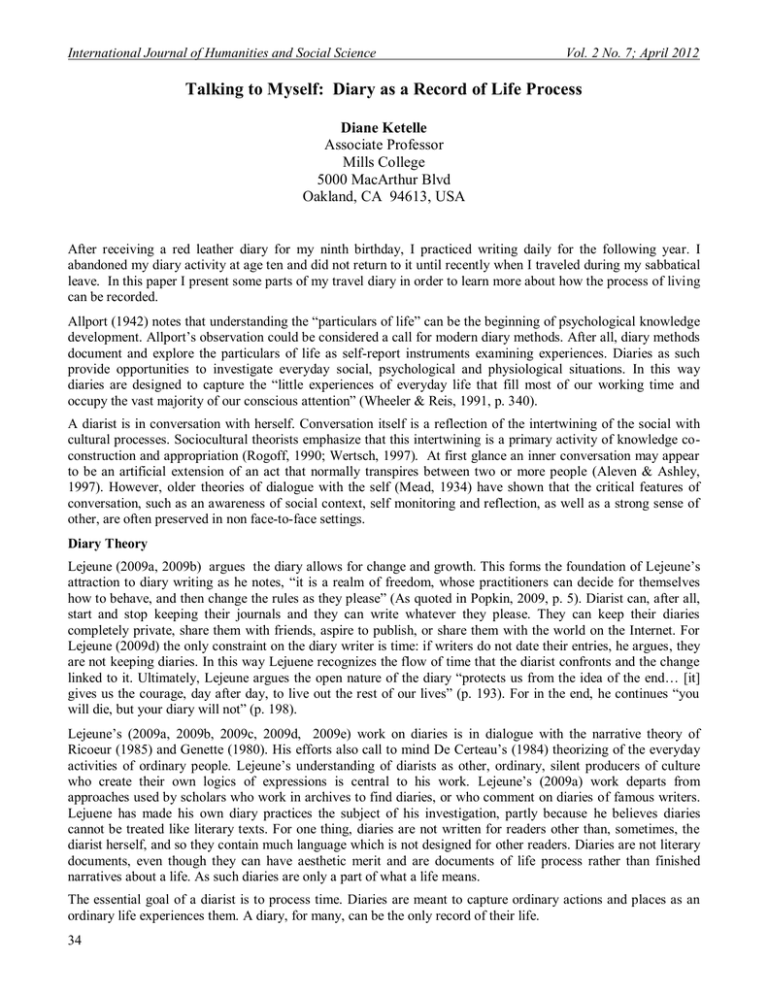
International Journal of Humanities and Social Science Vol. 2 No. 7; April 2012 Talking to Myself: Diary as a Record of Life Process Diane Ketelle Associate Professor Mills College 5000 MacArthur Blvd Oakland, CA 94613, USA After receiving a red leather diary for my ninth birthday, I practiced writing daily for the following year. I abandoned my diary activity at age ten and did not return to it until recently when I traveled during my sabbatical leave. In this paper I present some parts of my travel diary in order to learn more about how the process of living can be recorded. Allport (1942) notes that understanding the “particulars of life” can be the beginning of psychological knowledge development. Allport’s observation could be considered a call for modern diary methods. After all, diary methods document and explore the particulars of life as self-report instruments examining experiences. Diaries as such provide opportunities to investigate everyday social, psychological and physiological situations. In this way diaries are designed to capture the “little experiences of everyday life that fill most of our working time and occupy the vast majority of our conscious attention” (Wheeler & Reis, 1991, p. 340). A diarist is in conversation with herself. Conversation itself is a reflection of the intertwining of the social with cultural processes. Sociocultural theorists emphasize that this intertwining is a primary activity of knowledge coconstruction and appropriation (Rogoff, 1990; Wertsch, 1997). At first glance an inner conversation may appear to be an artificial extension of an act that normally transpires between two or more people (Aleven & Ashley, 1997). However, older theories of dialogue with the self (Mead, 1934) have shown that the critical features of conversation, such as an awareness of social context, self monitoring and reflection, as well as a strong sense of other, are often preserved in non face-to-face settings. Diary Theory Lejeune (2009a, 2009b) argues the diary allows for change and growth. This forms the foundation of Lejeune’s attraction to diary writing as he notes, “it is a realm of freedom, whose practitioners can decide for themselves how to behave, and then change the rules as they please” (As quoted in Popkin, 2009, p. 5). Diarist can, after all, start and stop keeping their journals and they can write whatever they please. They can keep their diaries completely private, share them with friends, aspire to publish, or share them with the world on the Internet. For Lejeune (2009d) the only constraint on the diary writer is time: if writers do not date their entries, he argues, they are not keeping diaries. In this way Lejuene recognizes the flow of time that the diarist confronts and the change linked to it. Ultimately, Lejeune argues the open nature of the diary “protects us from the idea of the end… [it] gives us the courage, day after day, to live out the rest of our lives” (p. 193). For in the end, he continues “you will die, but your diary will not” (p. 198). Lejeune’s (2009a, 2009b, 2009c, 2009d, 2009e) work on diaries is in dialogue with the narrative theory of Ricoeur (1985) and Genette (1980). His efforts also call to mind De Certeau’s (1984) theorizing of the everyday activities of ordinary people. Lejeune’s understanding of diarists as other, ordinary, silent producers of culture who create their own logics of expressions is central to his work. Lejeune’s (2009a) work departs from approaches used by scholars who work in archives to find diaries, or who comment on diaries of famous writers. Lejuene has made his own diary practices the subject of his investigation, partly because he believes diaries cannot be treated like literary texts. For one thing, diaries are not written for readers other than, sometimes, the diarist herself, and so they contain much language which is not designed for other readers. Diaries are not literary documents, even though they can have aesthetic merit and are documents of life process rather than finished narratives about a life. As such diaries are only a part of what a life means. The essential goal of a diarist is to process time. Diaries are meant to capture ordinary actions and places as an ordinary life experiences them. A diary, for many, can be the only record of their life. 34 © Centre for Promoting Ideas, USA www.ijhssnet.com Feminist scholars have argued that diary is a form of feminine autobiography (Wink, 2001) or “…the “real” voice of their writers” (p. 129). Wink argues that through writing diaries women can fortify and maintain their selfunderstanding as they adapt to circumstances. Blodgett (1988) suggests, “…diary keeping has been practiced so extensively by women because it has been possible for them and gratifying to them” (p. 5). In other words, women keep diaries because they like to. Davis (1987) argues that diaries offer important insights into women’s use of writing as “a significant coping mechanism” (p. 5). Maintaining diaries, for example, aided pioneer women in coping with the challenges of frontier travel and existence. A social scientist can experiment with producing photographs as a diary, or as I have done, use photographs with diary writing. A few visual artists have produced drawings or paintings in diary form (Kitson, 1982; Kelly, 1983). Chaplin (2004), a social scientist, has produced a rare example of a photographic diary that spanned a fifteen year period. Her photographic diary records moments from her life frozen in time. Methods Diaries provide all social science fields with a powerful set of methods for studying various human phenomena. A reflective research process “is regarded as being subject to a variety of influences which impact upon the interpretations generated” (Nadin & Cassell, 2006, p. 208) requiring a reflective stance. In this way, through the diary method reflection can be defined as “the interpretation of interpretation and the launching of critical self exploration of one’s own interpretations” (Alvesson & Skoldberg, 2000, p. 6). Although reflection can result in powerful learning, the success of reflective activity is entirely dependent on the commitment of the researcher (Johnson & Duberley, 2003). There is also little information available to researchers on how to “do” reflection (Mather & Doucette, 2003) and as such a diary provides a tool for practice. This sort of meaning making underscores a fundamental benefit of diary methods as they permit the examination of events and experiences in their natural, spontaneous context, providing information complementary to the obtainable through more traditional designs (Reis, 1994). Already a committed qualitative researcher, my interest in keeping a travel diary was partially the product of a newly acquired interest in writing more creatively and the recognition of the importance of reflexivity and its consistency with my research interests and orientation. My diary was a simple notebook. I wrote in it mostly in the evenings after a full day of activity. Each new entry commenced on a new page, starting with the date. The diary provided a forum for me to process my wildly new experiences, as well as observations which might otherwise have been lost or simply not considered later. The entries that follow were written while I was in India. I have woven multiple entries into a story, so in that way, this is a kind of selective diary. Once home, I glued photographs taken on the trip by myself and others into my diary. My process was fluid and developed like this: Step 1 I traveled to India and made entries in my travel diary. Step 2 I returned home and read my diary and reflected on my trip. Step 3 I glued photographs into my diary that related to various entries. Step 4 I wove multiple entries together to create a cohesive story. What follows is the story I created from entries in my travel diary. My Diary Sowing seeds of boldness, I boarded the plane to Amritsar. My friend, Anita Sufi, a Punjabi Sikh immigrant from Canada, conjured up the idea to steal away to India. It is my first trip there, though India has been a part of my life since I was a schoolgirl. I grew up in Yuba City, California, a popular destination for Punjabi Sikh farmers who immigrate to the United States. It is an agricultural area in the northern part of the state, where the terrain and weather are similar to the Punjab. From morsels of Indian delicacies, bangles and saris, to a long term relationship with a Punjabi Sikh man, India has been ever present in my personal universe. Traveling to the northwest corner of the colossal country, Amritsar is about 20 miles from Lahore, Pakistan, with a population of nearly two million. 35 International Journal of Humanities and Social Science Vol. 2 No. 7; April 2012 Steeped in both poverty and wealth, India is full of electric colors. Iridescent pigmentation and a spectroscope of chromatics embrace me everywhere: violet, indigo, jet black, ultramarine, ocher, emerald green, amethyst, scarlet, cinnabar, milky white, and banana yellow. The wash of watercolor, pastel and crayon was constant, flamboyant and flashy, emblazoning a clear place for the human heart on the fabric of a sari or a sign. We are lodging with Anita’s relatives on their farm. Anita’s parents, Gogi and Sohan, are also visiting. Iqbal, Anita’s father’s younger brother, who we called Chachagi, lives on the farm year round. Sukminder, Chachagi’s son, and Puneet, his wife, live there with their baby daughter, Manet, everyone’s happy preoccupation. Sodia, a 19 year old servant girl, also resides there. The brick farmhouse sits in the middle of acres of breathtaking wheat fields and life on the farm is homespun ungarnished, unvarnished, in plain terms, pure and simple, yet full of interaction. There are no secrets in that farmhouse and solitude is hard to acquire. Anita and I would sit on the roof at night, fighting off mosquitoes to enjoy the quiet solitude. The milk we drink is from the cow behind the house, the bananas from the trees that line the driveway, the mangos, as big as cantaloupe, are from the front yard, and vegetables from the garden. We eat all our meals together and talk from sun up to sun down. Puneet is an imaginative cook using spices creatively – cumin, coriander, and chilies made our meals delectable treats. It is a good life, at worst, prone to meddlesomeness, and at best, providing comfort to everyone. 36 © Centre for Promoting Ideas, USA www.ijhssnet.com The down to earth lifestyle suits me and, although never a person to sleep with one eye open, I rest soundly on the hard wooden bed with an unadorned flat cushion. At 5:30AM the Sikh priests from the two surrounding gurdwaras begin reading morning prayers over loud speakers. Waking up to a cacophony of Punjabi resonance reverberates in my soul. Walks on the dirt roads surrounding the farmhouse require a stick to fight off poisonous snakes and other animals that can pop out from the field wanting to wrestle. I haven’t encountered any wild beasts, but I have heard plenty of stories. The first day on the farm, the door to our shared bedroom swung open and a gleeful Sodia flew in followed by Gogi, whose elegance wasn’t forsaken in the excitement: “Are you up?” Anita and I sat up in the large bed, the day had started with an airy hope as we observed the squall of flurry and flitter, bustle and hubble bubble around us. It was clear the morning had been set in motion. Restless, almost nomadic, I felt I should pull up stakes, get out of dodge or just get myself moving. “We have to pick up Kuku Mama,” Gogi said, “We confused the time and we need to get going.” Kuku Mama was Anita’s mother’s younger brother who was visiting from Fresno, California. His flight arrival from New Delhi had been confused and now a skittish tizzy was propelling us into the day. Since Kuku Mama would only be at the farm for one day, time was of the essence. “No time to dally, up with you!” Gogi continued. Her cheerfulness emboldened me and made me want to cling to her like ivy or a burr. Gladsomely, I rolled out of bed and followed the fashion of the day by smiling and laughing, knowing the pageantry was a memento I would cherish. Out front Sohan, Anita’s father, a thinking man who was prone to controversialish wrangling, was organizing our wheels into the city. Lovlie, our 22 year old hired driver, had already arrived. He made his way down the long dirt driveway, turned his white Ford Explorer around at the farmhouse gate, and had the car facing the main road to Amritsar. I got dressed as the breezy, gusty happiness of the day whirled and created a positive undercurrent. Heading out with zest and confidence I tripped and pirouetted like a windmill propeller on the front porch. Even baby Manet laughed, and we loaded in the car, our excursion began. 37 International Journal of Humanities and Social Science Vol. 2 No. 7; April 2012 Driving to Amritsar Journeying to Amristar was excellent theater. The driving rules in India are a cross between “Chicken” and “Russian Roulette.” Lovlie was seldom in his assigned lane, zigzagging in and out, weaving around carts and scooters with the motion of a pendulum. The mission required stealth accuracy. The car rocked, vibrated, quivered, quavered, teetered and seesawed as we remained in forward motion. Anita was often annoyed with Lovlie’s driving saying, “Take it easy, Lovlie,” but it seemed to have no impact on him. To avoid being scared to death on our thirty minute drive, I alternated between watching every detail and closing my eyes. As we arrived in Amritsar there were people everywhere: to the four winds, to the utter most part of the earth, from all points on a compass, from pole to pole. The sheer number was beyond anything I had imagined: throngs, gangs, crowds, packs – wall to wall people. As we drove through the city mobs surrounded our car. In Amritsar, hordes fill the sidewalks and the streets: on bikes, on foot, pushing carts, running or walking. Honk, crash, rattle – the din and uproar was deafening as dusty powder filled the air: lint, ash, soot, earth. Among the crowds cows and pigs roam aimlessly. Burdensome remnants of a former British colony were observable. From British English, which was spoken by nearly everyone, to the white gloves on waiters in upscale restaurants, the hueless history remains. We picked up Kuku Mama at the small airport. He was a waggish, mirth loving man who had waited for us, but waiting hadn’t dampened his spirit. He boarded the car with a smile full of affability and we headed to the Harmandir Sahib, the Golden Temple. The Golden Temple After parking, we walked to the Golden Temple. The spiritual center for the Sikh religion it was built in 1585AD; the temple complex has four entrances signifying the acceptance of all people. I removed my shoes, and I covered my head with a colorful pink scarf. As I emerged from the entrance the grandeur of the temple’s brilliance and elegance of form came into full view. I wondered: what is goodness, justice, truth or mercy? What does it mean to sanctify, glorify, justify or bless? All at once I wanted to bob a curtsy, kneel, bow, bend a knee and prostrate myself. Standing there I felt like an isthmus between a world I knew to my core, and this new world offering me insight, perception and knowledge. Anita encouraged me to touch the holy water of Lake Sarovar, the pool surrounding the temple. As I bent down my sunglasses fell into the pool. Anita laughed and predicted we would see those glasses on a guard the next time we visited the temple. The heat was flaming and the marble walkways were peppery hot, burning our bare feet. We kept to the red and green carpets as we made our way. Gogi taught me how to give prashad, a sacred sweet pudding, the offering of ardas, given before reading a hukam from the granth sahib. She and I got in the women’s line, sweat dripping; we were squished and mashed by women on all sides, as we made way to make the offering. The Golden Temple is a gurdwara that provides the custom of langar, a community meal.The temple welcomes up to 100,000 visitors a day and two dining rooms feed up to 700 people at a time. 38 © Centre for Promoting Ideas, USA www.ijhssnet.com The concrete floors have rows of narrow red carpet for diners to sit on as volunteers scoop food onto their metal plates. Clang, bang, ping, the twang and tones reverberated and resonated through the vast halls. Broods of people make odious noises as 80,000 people a day are fed. Hundreds of volunteers make langar and help clean up. We didn’t eat langar on our first day, but we would eat another time and Anita would get irritated with me for having to finish my plate, but this day was filled with tranquilizing contentment. The Mall Walking the streets of Amritsar outside the Golden Temple required hand holding and verve. Drained and depleted from our morning adventure Gogi directed Lovlie to “The Mall” where we would have lunch. The ride was full of hubbub and fluster as Lovlie drove the wrong way down a one way street to get there. Moving from the sublime to the ridiculous, a modern, up to date, contemporary mall, like the one in Pleasant Hill, California where I live, had been built in the middle of Amritsar. We ate pizza in the food court and walked around enjoying the wellspring of dresses, trinkets, bracelets, bangles, and ornaments, all gleaming, glossy and lustrous. Everywhere I went in India I experienced sharp contrasts – the Golden Temple and the mall, an old wooden cart pulled by a water buffalo next to the Ford Explorer, kitchens with hot plates inhabited by cooks with cell phones. It is unceasing. The Ride Home Exhausted from our day, drained and weakened of our vigor we headed back to the farm. Puneet had a meal ready for us and we played cards on the porch after dinner. Kuku Mama watched a cricket match on the flat screen television as the evening breeze wafted through the wheat. Gogi fed the puppy, Elmo, and put him in his box to sleep. Summary and Conclusions When I engaged in writing a diary in India I was not considering my action as social research. However, in the entries shared here there is evidence of perspective taking, appreciative imagination and sometimes sharp, somewhat precise analytic skills. Travel to new places provides opportunity to shape and reshape personal activity – be it through novel activities or spending time with new friends, these functions add to the trip itself and what an individual can take away from it. Viewing a small part of my trip to India through a diarist’s perspective provided me with a unique window to process lived experience and construct new meaning to take forward on new travels or in daily living. The act of the diarist is recording the ordinary or in this case, my not so ordinary trip to India. I did not think about my trip at the time as social science research, but upon my return I began reflecting on all the various ways I can explore the social world. My trip to India took me inside a culture that was new, yet each day I continued living my ordinary life. My lived experience ended up being recorded in my travel diary and matters as an example of how one individual made meaning from an experience. This is process oriented research focused on a life lived. Rather than observing and recoding, the diary is a place to write freely. This approach, in large part, is anti-intellectual and seeks to document a sort of inner dialogue. My diary was a way of keeping track of time and myself. Lejeune (2009c) reminds us that diaries are guided by discontinuity rather than continuity. Diaries “show an identity in process, even as they are part of the process itself in creating identity, day after day” (Rak, 2009, p. 24). Lejuene (2009c) calls diaries “traces” (p. 176) of life forming “a piece of lacework or a spider web” (p. 177) where there are gaps and omissions because only the writer can know the path they will create. Lejuene’s (2009e) theorizing of the private writing world, in turn returns to the social world which shapes it: A diary is not only a place of asylum in space; it is also an archive in time. I escape the present and make contact with a vast future. I lay by provisions for a future writer, and leave traces for a future adult whom I am helping by recoding his history, someone who will later help me better understand the confusion I am experiencing. We are helping each other across time (p. 324). Diaries are intimate, personal and episodic. Didion (1980) has written that the act of writing is the very “act of saying I” (p. 17). If that is so, the writings from my diary are the way I have made myself visible in the world. Through weaving diary entries together I was able to make meaning and the narrative that was created is, therefore, is a representation of the process of my life. These chiseled memories are now salted away deep inside me – a wheat field, a dirt road, a hot noisy day, and a baby – a window into my place in this enormous, mountainous, massive, impressive, bulky, weighty world. My adventure to India lives in me as a slow as molasses daydream reminding me that life is forever worth it and each moment is worth recording. 39 International Journal of Humanities and Social Science Vol. 2 No. 7; April 2012 Punjabi Terms Ardas – A prayer Chacha – A father’s younger brother Granth sahib – The holy book of the Sikhs Gurdwara – A Sikh temple Harmandir Sahib – The Golden Temple Hukam – A verse read randomly from the scripture Kuku Mama- A mother’s younger brother Langar – A free, community meal at any gurdwara Prashad – A blessed offering References Aleven, V. & Ashley, K. (1997). Evaluating the learning environment for case based argumentation skills. Proceedings of the Sixth International Conference on Artificial Intelligence and Law, ICAIL-97, Melbourne, Australia. New York: Association for Computing Machinery. Allport, G. (1942). The use of personal documents in psychological science. New York: Social science research Council. Alvesson, M. & Skolberg, K. (2000). Reflexive methodology: New vistas in qualitative research. London: Sage. Blodgett, H. (1988). Centuries of female days: Englishwomen’s private diaries. New Brunswick, NJ: Rutgers University Press. Chaplin, E. (2004). My visual diary. In C. Knowles & P. Sweetman (Eds.), Picturing the social landscape: Visual methods and the sociological imagination (pp. 35-48). London: Routledge. De Certeau, M. (1984). The practice of everyday life. Berkeley, CA: University of California Press. Davis, G. (1987). Women’s frontier diaries: Writing for good reason. Women’s Studies, 14, 5-17. Didion, J. (1980). Why I write. In J. Sternburg (Ed.), The writer on her work (pp. 17-25). New York: Norton. Genette, G. (1980) Narrative discourse: An essay in method. New York: Cornell University Press. Johnson, P. & Duberley, J. (2003). Reflexivity in management research. Journal of Management Studies, 40(5), 1279-1303. Kelly, M. (1983). The post partum document. London: Routledge and Keegan Paul. Kitson, L. (1982). The Falklands war: A visual diary. London: Mitchell Beazly International in association with the Imperial War Museum. Lejeune, P. (2009a). The diary on trial. In J. Popkin & J. Rak (Eds.). On diary (pp. 147-167). Manoa, HW: University of Hawaii Press. Lejeune, P. (2009b). Composing a diary. In J. Popkin & J. Rak (Eds.). On diary (pp. 168-174). Manoa, HW: University of Hawaii Press. Lejuene, P. (2009c). The continuous and the discontinuous. In J. Popkin & J. Rak (Eds.). On diary (pp. 175-186). Manoa, HW: University of Hawaii Press. Lejuene, P. (2009d). How do diaries end? In J. Popkin & J. Rak (Eds.). On diary (pp. 187-200). Manoa, HW: University of Hawaii Press. Lejuene, P. (2009e). Lucullus dines with Lucullus. In J. Popkin & J. Rak (Eds.). On diary (pp. 324-336). Manoa, HW: University of Hawaii Press. Mauthner, N. & Doucet, A. (2003). Reflective accounts and accounts of reflexivity in qualitative data analysis. Sociology, 37(3), 413-431. Mead, G. (1934). Mind, self and society from the standpoint of a social behaviorist. Chicago: University of Chicago Press. Nadin, S. & Cassell, C. (2006). The use of a research diary as a tool for reflexive practice: Some reflections from management research. Qualitative Research in Accounting and Management. 3(3), 208-217. Popkin, J. (2009). Philippe Lejuene, explorer of diary. In J. Popkin & J. Rak (Eds.). On diary (pp. 1-15). Manoa, HW: University of Hawaii Press. Rak, J. (2009). Dialogue with the future: Philippe Lejeuene’s method and theory of diary. In J. Popkin & J. Rak (Eds.). On diary (pp. 16-26). Manoa, HW: University of Hawaii Press. Riceour, P. (1985). Time and narrative. Chicago: The University of Chicago Press. Reis, H. (1994). Domains of experience: Investigating relationship process from three perspectives. In R. Erber & R. Gilmore (Eds.), Theoretical frameworks in personal relationships (pp. 87-110). Mahwah, NJ: Erlbaum. Rogoff, B. (1990). Apprenticeship in thinking. New York: Oxford University Press. Wertsch, J. (1991). Voices of the mind: A sociocultural approach to mediated action. Cambridge, MA: Harvard University Press. Wheeler, L. & Reis, H. (1991). Self-recording of everyday life events: Origins, types and uses. Journal Personal, 59, 339-354. Wink, A. (2001). She left nothing in particular: The autobiographical legacy of nineteenth- century women’s diaries. Knoxville, TN: The University of Tennessee Press. 40



